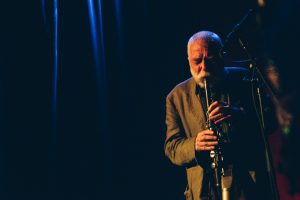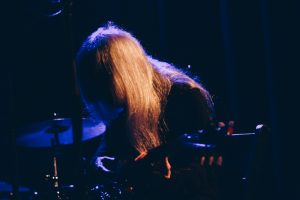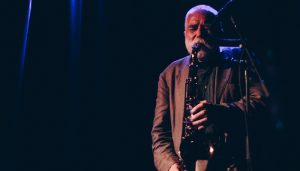REVIEW: Peter Brotzmann and Keiji Haino cast off the yoke of music theory at The Chapel

Keiji Haino performs at The Chapel in San Francisco on Aug 8, 2018. Photos: Shawn Robbins.
SAN FRANCISCO — Most agree that music communicates emotion through melody, harmony and rhythm. These are essentials that must be followed; restrictions concerning what can and can’t be played. Wednesday at The Chapel, German horn player Peter Brotzmann and Japanese vocalist and multi-instrumentalist Keiji Haino demonstrated that the emotional roar arising from our abyss obeys no rules.
The two jazz veterans’ performance threw out the rulebook and the resulting barrage that pummeled the audience for nearly two hours was a stunning display of unfiltered emotion.
The performance began when Keiji Haino stepped to the microphone. Dressed in all black with his flowing white hair and dark sunglasses, resembling a combination of Johnny Winter and The Mod Squad cast member, the 66-year-old Haino proceeded to growl, gargle, shriek, make mosquito buzzings, and bark into the microphone. Meanwhile, Peter Brotzmann conjured a mournful drone.
His animal-like shrieking concluded, Haino banged on a handheld cymbal while lurching around stage. The 77-year-old Brotzmann, bearded, looking grisled and gray, and clad in a dark suit jacket and button down shirt, unleashed a howl that wandered around a particularly juicy part of the audio spectrum, somewhere past the notes near at end of the alphabet (you know, x, y and z). Haino, now seated at a drum kit, pounded like John Bonham falling into a K-hole.
After a prolonged drum solo, which Brotzmann watched from the far side of the stage, Haino strapped on a guitar, the instrument he is most closely associated with, and the music became even more frenetic.
While free music lacks the usual signposts like riffs and repetition that allow players to make complimentary sounds, these veteran musicians, who’ve collaborated with everyone from free jazz legend and poet Cecil Taylor to sometime-Sonic Youth member Jim O’Rourke, manage to find each other in the chaos, sometimes answering one angry skronk with another. At other times, the dialog was more nuanced, with angular guitar jangles played against saxophone and clarinet tones that fluttered around the venue like a flock of birds on LSD.
With Haino on guitar, the music lurched and wandered through texture after texture. His style was unorthodox. At times he slapped the strings frantically or paws at them clumsily, at others he banged his closed fist against the back of the guitar’s neck. It’s a little like someone who has never seen or heard a guitar before explaining to someone else how to play the guitar and what it should sound like. Still, you got the sense that this musician is incredibly talented and practiced at the chaos he makes.
Haino strummed slightly discordant jazz chords and Brotzmann created cascading sheets of sound, composed of complex chains of notes. Together, they produced musical anacoluthons; sentences that lacked a grammatical sequence.
After conjuring a fiery flurry of feedback from his amplifier and twice dislodging the amp’s microphone, Haino put down his guitar and began to beat two handheld drums resembling large tambourines. Brotzmann made strange, reedy sounds with his clarinet, and Haino returned to the microphone, singing softly and indecipherably to bring the show to a close. The two performers bowed to one another and left the stage.
While “free music” is purported to have cast off harmony, melody and rhythm, the enthusiastic crowd at The Chapel could hear those elements very clearly right there in the jet engine of sound being blasted at them. Melody was the squeal of the saxophone, harmony the feedback of the guitar, and rhythm the abrupt bangs and silence of the cymbal.
Freed from the strictures of tradition, the music became sounds, and the sounds resisted identification. They became more personal and intimate, evoking joy as fans were perpetually surprised. Because they weren’t sure exactly what they were hearing, they tuned in more closely, noticing nuance and detail that are typically overlooked in a pop song.
Follow writer David Gill at Twitter.com/DavidGi18788752. Follow photographer Shawn Robbins at Instagram.com/photo_robbins and Twitter.com/shawnTHErobbins.



